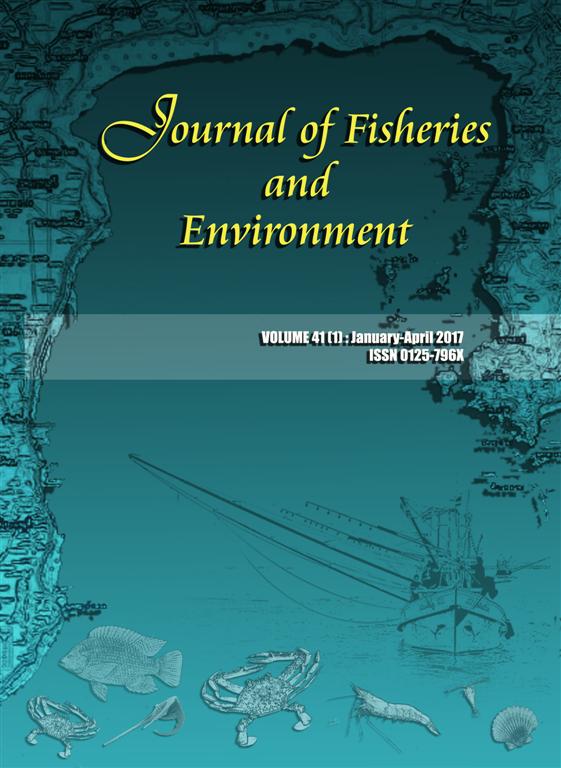The Impact of Fish Cage Culture on Water Quality of Taasarn-Bangpla Canal, Nakhon Pathom Province,Thailand
Main Article Content
Abstract
Concerns over the impact of cage culture on water quality alteration arose when the number of fish cages in the Taasarn-Bangpla Canal in Nakhon Pathom province, Thailand increased. This study aimed to assess the impact of cage culture on the water quality of the canal. Water quality in three stations around the dense cage culture areas were monitored monthly from October 2013 to August 2014. Dissolved oxygen, pH, temperature and transparency were monitored in situ. Water samples for analysis of phosphorus, ammonia and BOD5 were analyzed at the Water Chemistry Laboratory by standard methods. The study found that water quality is influenced by wastes released from different activities and apparently influenced by seasonal water flow regime. Water quality, particularly dissolved oxygen, from January to July are considerably good when the accumulated water flow was more than 40x106 m3/month. Poor water quality occurs when the flow was less than 40x106 m3/month. High flow period had significantly higher dissolved oxygen than during the low flow period, whereas alkalinity, hardness, ortho-phosphate phosphorus, and total ammonia were significantly low. Statistical indifference in water quality among the three stations was due to predominating temporal variation. However, water quality tended to be altered from upstream to downstream due to wastes generated from different activities in and along the river basin. The approximately 1,057 tonnes annual production of red tilapia currently has, no doubt, worsened the situation. Self-inflict of cage culture and other water users living downstream could suffer from poor water quality if the current situation is allowed to continue without environmental impact mitigation/prevention measures.
Article Details
References
2. Avnimelech, Y. 2015. Biofloc Technology-A Practical Guide Book, 3rd Edition. The World Aquaculture Society, Baton Rouge, Louisiana, United States.
3. Belton, B., Turongruang, D., Bhujel, R. and Little, D.C. 2009. The History, Status, and Future Prospects of Monosex Tilapia Culture in Thailand. Aquaculture Asia Magazine, August 2009.
4. Beveridge, M.C.M. and Stewart, J.A. 1998. Cage Culture: Limitations in Lakes and Reservoirs. Inland Fishery Enhancements. Papers Serial: FAO Fisheries Technical Paper (FAO), no. 374.
5. Guo, L. and Li, Z. 2003. Effects of nitrogen and phosphorus from fish cage-culture on the communities of a shallow lake in middle Yangtze River basin of China. Aquaculture 226 (2003) 201-212. www.elsevier.com/locate/aqua-online.
6. Neto, R. M. and Antonio, O. 2013. Nutrient load estimation in the waste of Nile tilapia Oreochromis niloticus (L.) reared in cages in tropical climate conditions. Aquaculture Research 46(6): 1309-1322, June 2015.
7. Pollution Control Department. Surface Water Standard. http://www.pcd.go.th/info_serv/en_reg_std_water05.html, searched on 19 June 2016.
8. Sihapitukgiat, P., B. Sricharoendham, R.Kittivorachate, S. Ingthamjitr and T. Chittapalpong. 2000. Growth Performance, Production Model, Environmental Impact and Economics of Commercial Nile Tilapia Cage Culture in the Northeast of Thailand. Technical Paper No. 204, National Inland Fisheries Institute, Department of Fisheries, Ministry of Agriculture and Cooperatives, Bangkok, Thailand. In Thai.
9. Simachaya, W. 2002. Water Quality Monitoring and Modeling Application in Thailand. Paper prepared for the Third World Water Forum Session "Water Quality Monitoring and Modeling- The Present Situation and Partnership in the Future "October 16-17, 2002 at the United Nation University Center in Tokyo, Japan.
10. Tirado, R., Andrew J. Englande, Luksamee P. and Vladimir N. 2008. Greenpeace Research Laboratories Technical Note 03/2008 February 2008. Search from http://www. greenpeace.to/publications/GPSEA_agrochemical-use-in-thailand.pdf
11. Valbuena-Villarreal R., D. and Vasquez-Torres, W. 2011. Body weight is inversely associated with ammonia excretion in red tilapia (Oreochromis sp). Colomb Cienc Pecu 2011; 24: 191-200.

